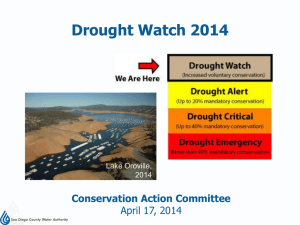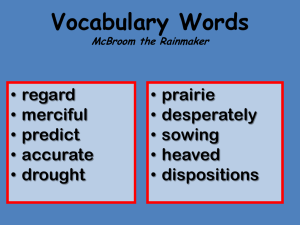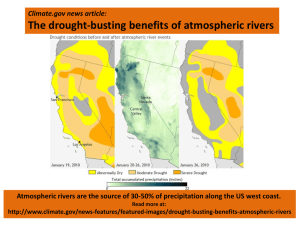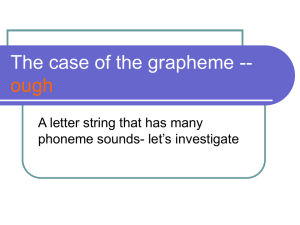Range Management and Drought
advertisement
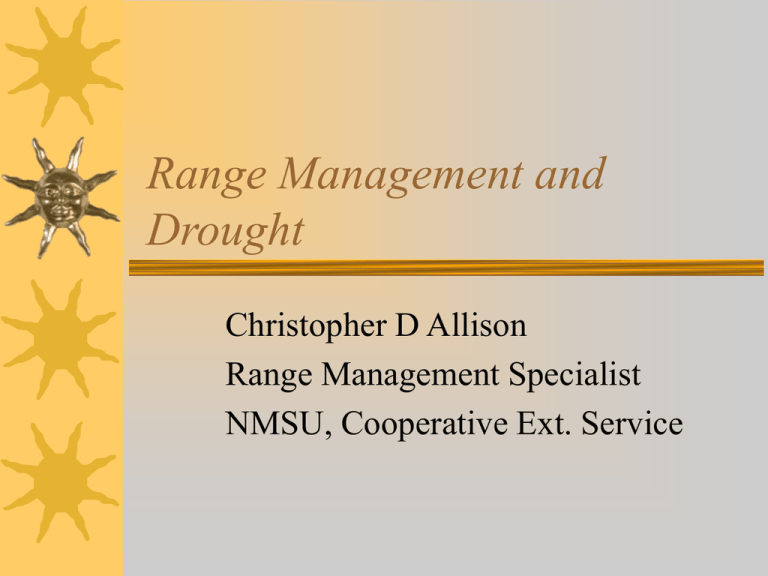
Range Management and Drought Christopher D Allison Range Management Specialist NMSU, Cooperative Ext. Service What Is a Drought? Indonesia: 6 days without rain. Lybia: 2 years without rain. Society for range management: precipitation is ¾ of the average or less. Palmer drought index weights accumulated differences between precipitation and evapotranspiration. Most people have little difficulty recognizing a drought. Palmer Drought Severity Index Created in 1965. Based on IA, KS studies. Based on Precipitation, Temperature and Available Water Content (AWC) of the soil. Most effective in determining long term droughts. Rain is only precipitation used. “Meteorological” not “Hydrological”. Palmer Drought Severity Index 4.0 or More………….Extremely Wet 3.0 to 3.99 …………Very Wet 2.0 to 2.99 ………… Moderately Wet 1.0 to 1.99 …………..Slightly Wet 0.5 to 0.99……………Incipient Wet Spell 0.49 to –0.49…………Near Normal Palmer Drought Severity Index 0.49 to – 0.49 …… Near Normal - 0.5 to – 0.99 …… Incipient Dry Spell - 1.0 to – 1.99……. Mild Drought - 2.0 to – 2.99 …… Moderate Drought - 3.0 to – 3.99 …….Severe Drought - 4.0 to – 4.99……. Extreme Drought years (1912-2000) 2000 1996 1992 1988 1984 1980 1976 1972 1968 1964 1960 1956 1952 1948 1944 1940 1936 1932 1928 1924 1920 1916 1912 inches Precipitation Portales New Mexico 50 45 40 35 30 25 average precipitation 20 15 10 5 0 Average precipitation by decade 20.00 18.00 16.00 14.00 12.00 10.00 average 8.00 6.00 4.00 2.00 0.00 10's 20's 30's 40's 50's 60's 70's 80's 90's 19 30 19 33 19 36 19 39 19 42 19 45 19 48 19 51 19 54 19 57 19 60 19 63 19 66 19 69 19 72 19 75 19 78 19 81 19 84 19 87 19 90 19 93 19 96 19 99 inche s precipatation: average 9.11inches 20.00 18.00 16.00 14.00 12.00 10.00 8.00 6.00 4.00 2.00 0.00 years decades: average 9.11 inches 12.00 10.00 8.00 inches 6.00 4.00 2.00 0.00 1930s 1940s 1950s 1960s 1970s decades 1980s 1990s 2000s National Climatic Data Center World’s Largest Archive of Weather Data www.ncdc.noaa.gov National Climatic Data Center Drought Years: 66% of the Time Impacts of Drought Severe reduction in forage production(6-7 fold fluctuation). High mortality to range grasses whether grazed or not ( 50% mortality not uncommon). Range Management Principles Proper stocking rate. Proper livestock distribution. These remain the same during drought or good years. Will the Real Stocking Rate Please Stand Up! Is there one stocking level that will be right for my ranch for all time? Constant & Conservative vs. Flexible. years (1912-2000) 2000 1996 1992 1988 1984 1980 1976 1972 1968 1964 1960 1956 1952 1948 1944 1940 1936 1932 1928 1924 1920 1916 1912 inches 50 45 40 35 30 25 20 15 10 5 0 If Drought Is Such a Highly Predictable Event (66%) Why Are We So Unprepared for One When It Occurs? The Role of Government in Drought The Role of Government in Drought Response USDA emergency feed program – replaced by the non-insured assistance program. These programs enable ranchers to stock at higher rates than would be wise. Why not provide incentives to ranchers for early de-stocking in response to dry conditions? The Role of Government in Drought Response(proposals) If politicians are intent on providing feed subsidies, ranchers should be required to produce a drought preparedness plan. In “official” drought areas, ranchers would receive payments for the duration of the drought and for a specified period afterwards.(CRP model). The Role of Government in Drought The Agricultural Risk Protection Act of 2000: outlines the development of a pilot project for a pasture and range risk management program. The 2000 amendment to the Federal Crop Insurance Act requires the USDA’s Risk Management Agency to develop a risk management program for rangeland. The Role of Government in Drought 2002 “ Agreement to determine percent of grazing loss.” CES and NRCS will provide assessments of grazed forage acreage conditions to the local FSA County Committee. Guidelines for performing assessments will be established jointly by CES and NRCS. The Role of Ranchers in Drought Response. Constantly monitor forage supply and demand. Flexible stocking is a must. A “wait and see” management style has a high long-term cost. Soil erosion = less moisture holding capacity = more variability in forage production. The Role of Ranchers in Drought Response. Don’t try to feed your way out of a drought.This is similar to borrowing your way out of debt. Remember: you never know when the drought will end. Check dirt tanks. Reliance on piped water makes it easy to not react fast enough. Reliance on piped water makes it easy to not react fast enough. Drought Preparedness (Free Advice) 1. Maintain as much carryover forage as you can. 2.Have a flexible herd composition . 1/4 – 1/3 of the total stocking rate should be comprised of yearlings.OR keep more/cull heavier with replacement heifers. 3.Develop a drought reserve pasture. Always have a pasture that was rested the previous year. More Free Advice for Drought Preparedness 4. Sell early.This insures higher prices,and more grass for the remaining herd. 5. Cull heavier than normal. Open cows,older cows,body condition scores less than #4. 6. If you decide to feed your way out of a drought, feed “energy dense”supplements because you are short on energy (grass). Still More Free Advice 7. Wean early. Lactating animals consume 1/3 more feed than dry cows. 8. Have a de-stocking plan in writing. The heat and dust of the sorting pens is not a good place to think through the production and economic consequences of your decisions. Some More Free Drought Planning Advice 9. Set “critical dates”.There is a date on your ranch by which, if it has not rained, you know you are in trouble. Even if it rains, you will still be short of feed.Let everyone on the ranch know when it is and what the plan is. 10. Initiate your de-stocking plan on that date. 11. Being caught with too many cattle after that date, leads to poor prices and range deterioration. Free Drought Advice 12.Don’t drought feed. “Drought feeding leads to overstocking, deteriorated ranges and bankrupt ranchers.” 13. Beware of “free money”.Government programs may have a high cost to the range. Summary Hauling water,feeding livestock and crying in your beer won’t insure survival. These tend to reinforce the feeling of panic and deplete your bank account. Get a plan. Do an on-ground forage budgeting exercise. “Is there enough grass to last until the next growing season?” Forage Budgeting Is there enough grass to last until next growing season? Ex: 100 cows, 5000 acres, 10 months (Sept-June). 100 cows x 300 days / 5000 acres = 6 CDA. Each acre will have to support 6 cows for 1 day. Forage Budgeting 43,560 / 6 = 7,260 ft2 for 1 cow for 1 day. 85 ft x 85 ft is the area needed to check in the field. Perform this field check in several areas (avoid those “good spots”). RANGE READINESS!


